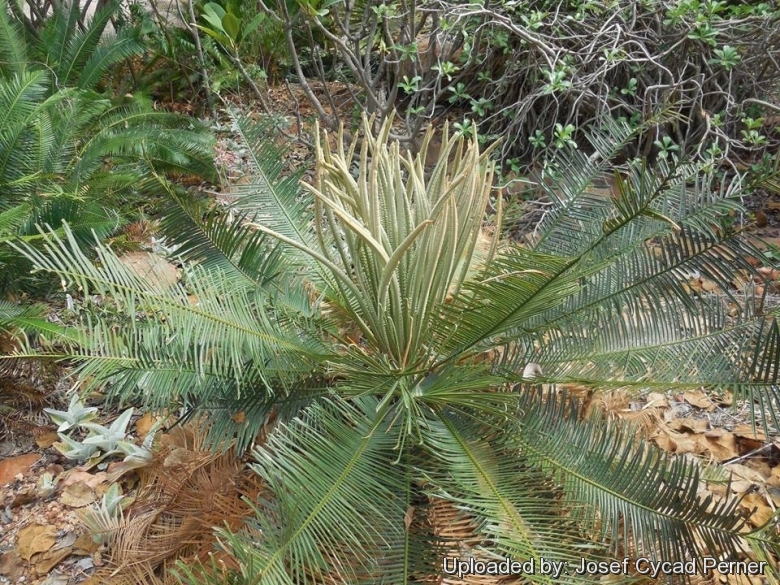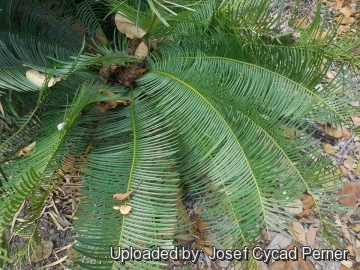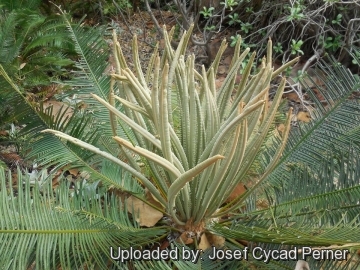




Your support is critical to our success.

Habit at: Cycad International, Cycad Specialty Export nursery, Katherine, Northern Territory, Australia
Origin and Habitat: Northern Territory, Australia. Cycas maconochieiSN|29474]]SN|29474]] ssp. viridis is known only from around Fossil Head. It has a very small extent of occurrence (100 km²), but the plants are scattered and locally abundant and there is little evidence of decline.
Habitat and Ecology: This taxon usually occurs on sandy soils or on old beach sands. The invasion of alien grasses into areas of native vegetation and too frequent fires may be a possible threat. The frequent fire may inhibit the reproduction of this species.
Synonyms:
- Cycas maconochiei subs. viridis K.D.Hill
Cycas maconochiei subs. viridis K.D.Hill
Telopea 7(1): 51 (1996).
Accepted name in llifle Database:
Cycas maconochiei Chirgwin & K.D.Hill
Telopea 7: 48 (1996)
Synonymy: 2
- Cycas maconochiei Chirgwin & K.D.Hill
- Cycas maconochiei subs. maconochiei (Chirgwin & K.D.Hill)
Cycas maconochiei subs. lanata K.D.Hill
Telopea 7(1): 49 (1996)
Description: Cycas maconochiei subs. viridis is a medium to tall palm-like cycad with slenderer woody trunk topped with long fronds arranged in a gracefully rounded crown arching out from the central trunk. Individual specimens take 10-20 years to mature and may live for up to 120 or more years. The seeds have orange-brown coloured flesh and are slightly pruinose.
Distinctive characteristics: This subspecies had glossy mid-green leaflets with recurved margins, becoming glabrous when older, and the thickly woolly cataphylls. Subsp. maconochiei from some distance farther north differs in the dull, flatter and more widely spaced leaflets, and the less densely tomentose cataphylls. Subsp. lanata, adjacent to the north and east, has narrower, dull leaflets.
Derivation of specific and subspecific name: The specific name honours the late John Maconochie, formerly botanist with the Northern Territory government, who had commenced a major revision of the genus Cycas. The subspecies epithet is from the Latin viridis, green, in reference to the bright green leaves.
Stems: Up to 3(-7) m tall, 9-15 cm diameter at narrowest point.
Leaves: Deep green or grey-green, semiglossy, 70-120 cm long, slightly keeled (opposing leaflets inserted at 130-160° on rachis), with 140-230 leaflets, with white and orange tomentum shedding as leaf expands or persistent above and below; rachis usually terminated by a spine. Petiole 18-33 cm long, glabrous or pubescent, unarmed or spinescent for 0-100% of length. Basal leaflets gradually reducing to spines. Median leaflets simple, strongly discolorous, 70-150 mm long, 3.5-7 mm wide, inserted at 60-90° to rachis, decurrent for 1.5-3 mm, narrowed to 2.5-4.5 mm at base (to 55-80% of maximum width), 5-10 mm apart on rachis; median leaflets section flat, or slightly keeled; margins slightly recurved, or recurved; apex aristate, spinescent; midrib flat above (or slightly raised), raised below.
Cataphylls: The cataphylls (Modified leaf, much reduced and thickened, serving to protect the apical meristem in cycads and produced in flushes preceding the emergence of cones or leaves.) are linear, soft, densely floccose, 60-80 mm long and persistent.
Pollen cones: Narrowly ovoid, orange, 20-34 cm long, 10-14 cm diam.; microsporophyll lamina firm, not dorsiventrally thickened, 25-35 mm long, 9-12 mm wide, fertile zone 20-27 mm long, sterile apex 5-8 mm long, level, apical spine prominent, sharply upturned, 4-8 mm long.
Female flowers: Like other Cycas species, the female plants do not bear cones; instead they carry ovules and seeds on large, grey-tomentose and brown-tomentose megasporophylls which are 20-27 cm long, with between 2 and 4 glabrous ovules. The lamina/blade or sterile part of the megasporophylls lanceolate, 40-60 mm long, 14-22 mm wide, regularly dentate, with 24-36 pungent lateral spines 1-4 mm long, 1 mm wide, apical spine distinct from lateral spines, 10 mm long.
Seeds: Flattened-ovoid, 33-36 mm long, 29-32 mm wide; sarcotesta orange-brown, slightly pruinose, 3 mm thick; fibrous layer absent; sclerotesta smooth. Spongy endocarp absent.
Subspecies, varieties, forms and cultivars of plants belonging to the Cycas maconochiei group
 Cycas maconochiei Chirgwin & K.D.Hill: (subsp. maconochiei) differs in the dull, flatter and more widely spaced leaflets, and the less densely tomentose cataphylls. Leaflets 5.5-7.0 mm wide, flat, margins slightly recurved, spaced at 8-10 mm on rachis (tomentum on leaves persistent light orange-brown or paler). Distribution: between Fog Bay and Port Darwin, to the southwest of Darwin, Northwest of Northern Territory, Australia.
Cycas maconochiei Chirgwin & K.D.Hill: (subsp. maconochiei) differs in the dull, flatter and more widely spaced leaflets, and the less densely tomentose cataphylls. Leaflets 5.5-7.0 mm wide, flat, margins slightly recurved, spaced at 8-10 mm on rachis (tomentum on leaves persistent light orange-brown or paler). Distribution: between Fog Bay and Port Darwin, to the southwest of Darwin, Northwest of Northern Territory, Australia. Cycas maconochiei subs. lanata K.D.Hill: the epithet is from the Latin lanatus, woolly, in reference to the densely tomentose cataphylls. Leaflets 3.5-5.5 mm wide, somewhat keeled, margins strongly recurved, spaced at 5-7 mm on rachis (tomentum on leaves persistent dark red-brown). Distribution: northern Wingate Mountains and adjacent plains country to the north and west, extending to the coast north of Peppimenarti, and west almost to Port Keats, Northern Territory, Australia.
Cycas maconochiei subs. lanata K.D.Hill: the epithet is from the Latin lanatus, woolly, in reference to the densely tomentose cataphylls. Leaflets 3.5-5.5 mm wide, somewhat keeled, margins strongly recurved, spaced at 5-7 mm on rachis (tomentum on leaves persistent dark red-brown). Distribution: northern Wingate Mountains and adjacent plains country to the north and west, extending to the coast north of Peppimenarti, and west almost to Port Keats, Northern Territory, Australia. Cycas maconochiei subs. viridis K.D.Hill: is distinguished by the relatively broad, glossy green leaflets, becoming glabrous when older, with recurved margins, and the thickly woolly cataphylls (tomentum on leaves not persistent). Distribution: only from around Fossil Head, Northern Territory, Australia.
Cycas maconochiei subs. viridis K.D.Hill: is distinguished by the relatively broad, glossy green leaflets, becoming glabrous when older, with recurved margins, and the thickly woolly cataphylls (tomentum on leaves not persistent). Distribution: only from around Fossil Head, Northern Territory, Australia.
Bibliography: Major references and further lectures
1) Ottley, H. 2010. Cycas maconochiei ssp. viridis. The IUCN Red List of Threatened Species. Version 2014.3. <www.iucnredlist.org>. Downloaded on 15 November 2014.
2) The Cycad Pages “Cycas maconochiei” Royal Botanic Gardens Sydney Written and maintained by Ken Hill 1998-2010 Maintained by Leonie Stanberg and Dennis Stevenson 2010-2012 >http://plantnet.rbgsyd.nsw.gov.au/cgi-bin/cycadpg?taxname=Cycas+maconochiei> Web. 13 Nov. 2014.
3) Haynes J.L, “World List of Cycads: A Historical Review” IUCN/SSC Cycad Specialist Group, 2012
4) Boris Lariushin “Cycadaceae Family” Lulu.com
5) Australia. Bureau of Flora and Fauna, Australian Biological Resources Study “Flora of Australia: Ferns, gymnosperms and allied groups” CSIRO, 1998
6) Walters & Osborne “Cycad Classification: Concepts & Recommendations”, Appendix 2 “Glossary of Terms Encountered in Cycad Systematics” <http://www.cycadsg.org/publications/CCC-Glossary.pdf>
7) Hill, K.D. & Osborne, R.O. “Cycads of Australia.” Kangaroo Press, Sydney. 2001
8) Jones, D.L. “Cycads of the World.” 2nd edn. Reed, Sydney. 2002.
9) Norstog, K.J. and Nichols, T.J. “The Biology of the Cycads.” Cornell University Press, Ithaca.1997
10) Walters, T. and Osborne, R. “Cycad Classification Concepts and Recommendations.” CABI Publishing, Wallingford UK. 2004.
11) Whitelock, L.M. “The Cycads.” Timber Press, Portland, Oregon. 2002
12) Palms & Cycads No. 27, Apr-Jun 1990.
13) Kennedy, P. (1993). "Cycas maconochiei". Cycads. Palm and Cycad Societies of Australia (PACSOA).12 December 2013 Web. 13 Nov. 2014.

- Fronds at: Cycad International, Katherine, Northern Territory, Australia Photo by: Josef Cycad Perner

- New emerging leaves at: Cycad International, Cycad Specialty Export nursery, Katherine, Northern Territory, Australia Photo by: Josef Cycad Perner
Cultivation and Propagation: Cycas maconochieiSN|29474]]SN|29474]] subs. viridis is suited to tropical regions which have a seasonally dry climate. It is easy to grow, tolerating dry periods. It makes a beautiful ornamental for tropical and some warm temperate areas but is rather rare in cultivation.
Growth rate: Usually slow growing, however good conditions can speed it up considerably. Because of its growth habit, fertilize only when terminal bud begins to swell, indicating the start of the annual growth cycle.
Exposure: It prefers bright light exposure but colour bleaches when in full sun; best with some protection from afternoon heat.
Soil: Needs a well drained spot, with deep soil, but will still thrive in less than ideal conditions.
Maintenance: Minimal; removal of offsets if desired, removal of spent fronds.
Use: Landscape as cultivated perennial in warm, coastal areas; House-plant or interior-scape, as container plant in cool areas, as well very well suited to bonsai culture.
Propagation: Seed. After fertile seeds are collected, they usually need several months of storage before the inner embryo is ready to germinate. Therefore, it is best to clean the seeds of external fruit and set them aside before attempting to propagate the seeds.
| Your Actions | |
|---|---|
| Back to Cycas index | |
| Back to Cycadaceae index | |
 |
Back to Palms And Cycads Encyclopedia index |
Privacy stantement - Terms and conditions - How to cite - About us - Feedback - Donate


